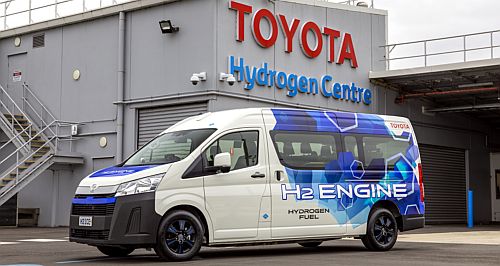News - Toyota - Hiace - HydrogenToyota HiAce H2 a global hydrogen pilotAustralian program to pave the way forward for hydrogen internal combustion technology11 Nov 2023 By MATT BROGAN FROM this month, Toyota Australia is testing a prototype hydrogen-fuelled internal combustion engine powered (H2-ICE) HiAce Commuter as part of an international pilot program it says will form another avenue of its multi-pathway approach to decarbonisation.
Initially, the vehicle will undergo real-world testing with CPB Contractors with daily reports on the vehicles progress fed back to head office.
The HiAce Commuter H2-ICE is said to produce only “ultra-low CO2 tailpipe emissions” while at the same time offering production and development cost benefits.
The 3.5-litre twin-turbocharged V6 (petrol) engine utilised in the application is identical to that found in other Toyota (LandCrusier 300 Series, Tundra, Sequoia) and Lexus (LX600) models, fitted only with different fuel injectors and a trio of hydrogen tanks (sourced from the Toyota Mirai).
It runs the same 10-speed automatic transmission and drives the rear wheels.
The V35A-series engine – which is available in the HiAce in other markets – has been modified to run on compressed hydrogen gas, using a unique direct-injection system, ECU tune, and SCR exhaust system with AdBlue injection. It meets Euro 6 emissions standards.
Maximum power is rated at 120kW (185kW less than the petrol equivalent) and 354Nm (-296Nm).
Toyota has yet to provide fuel consumption or emission figures but says the hydrogen powertrain fitted to the HiAce Commuter H2 results in almost zero CO2 tailpipe emissions, with the process of igniting hydrogen in the engine generating small amounts of oxides of nitrogen (NOx), which are reduced by the selective catalytic reduction system.
Beyond the driveline, Toyota says the 12-seat HiAce Commuter was selected for the prototype program for packaging reasons, the large van offering the opportunity to install the engine up front and the hydrogen tanks under the floor, ensuring minimal impact on space and payload.
Given range limitations of the prototype (limited to approximately 200km), it is currently best suited to worksite and shorter back-to-base operations.
“This technology offers the potential for Toyota to produce vehicles that meet the practical requirements of commercial customers while dramatically reducing CO2 tailpipe emissions,” said Toyota Australia president and CEO, Matthew Callachor.
“Toyota Australia is firmly committed to playing a leading role in the development of Australia’s hydrogen economy. Running the pilot program for this new hydrogen powertrain technology builds upon our substantial development and investment in the hydrogen space.
“Australia is the perfect place to run such a program with our federal and state governments having already committed $6.3 billion in funding for hydrogen projects under the National Hydrogen Strategy.
“We also have an extensive variety of environments and climatic conditions that will enable us to evaluate the hydrogen powertrain technology to its fullest and ensure it delivers on Toyota’s high standards.”
While the HiAce Commuter H2 is still in the infancy of its prototype phase, Toyota is evolving the technology on a continual basis, working to optimise hydrogen storage, improving combustion, and exploring the possibility of adding hydrogen technology – likely similar to that found in the Toyota Tundra.
It is understood the Australian H2-ICE program aims to fast-track the development of so-called hot hydrogen powertrains for use across a range of larger vehicles (LandCruiser, HiLux, etc.) with Toyota saying we will see a variety of potential customers using the HiAce H2 for either commuter or delivery-type operations in the not-too-distant future.  Read more27th of October 2023  Electric Toyota LandCruiser a chance for OzToyota unboxes hotly-anticipated electric LandCruiser at the Japan Mobility Show30th of August 2023  HiLux BEV concept leads Toyota showcaseBevy of new models highlights Toyota Australia’s growing driveline diversification14th of July 2023  Hyundai says hydrogen N cars possibleN Vision 74 concept car may become reality, setting the tone for future FCEV N models |
Click to shareToyota articlesResearch Toyota Hiace pricing
Motor industry news |
















Facebook Twitter Instagram